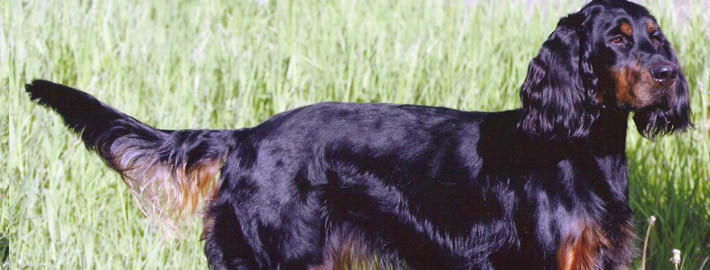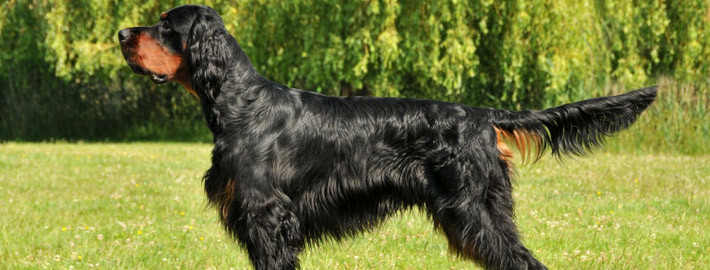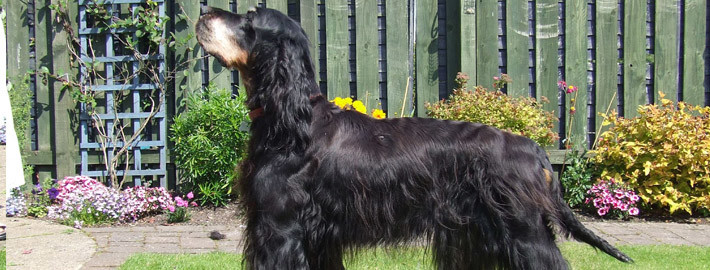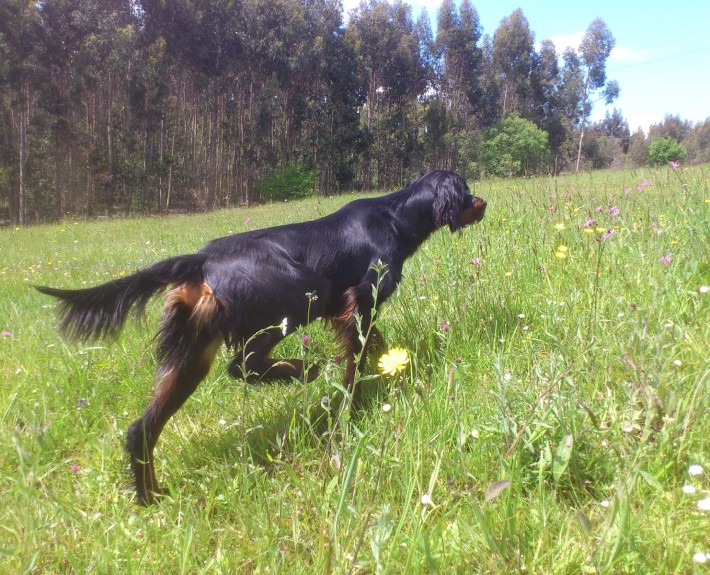What makes the Gordon Setter Unique?
An excellent dog for shooting and retrieving game, this breed has many other uses. This multitalented breed also makes a good watch and guard dog. They also are adroit trackers.
Breed Groups
Page Contents
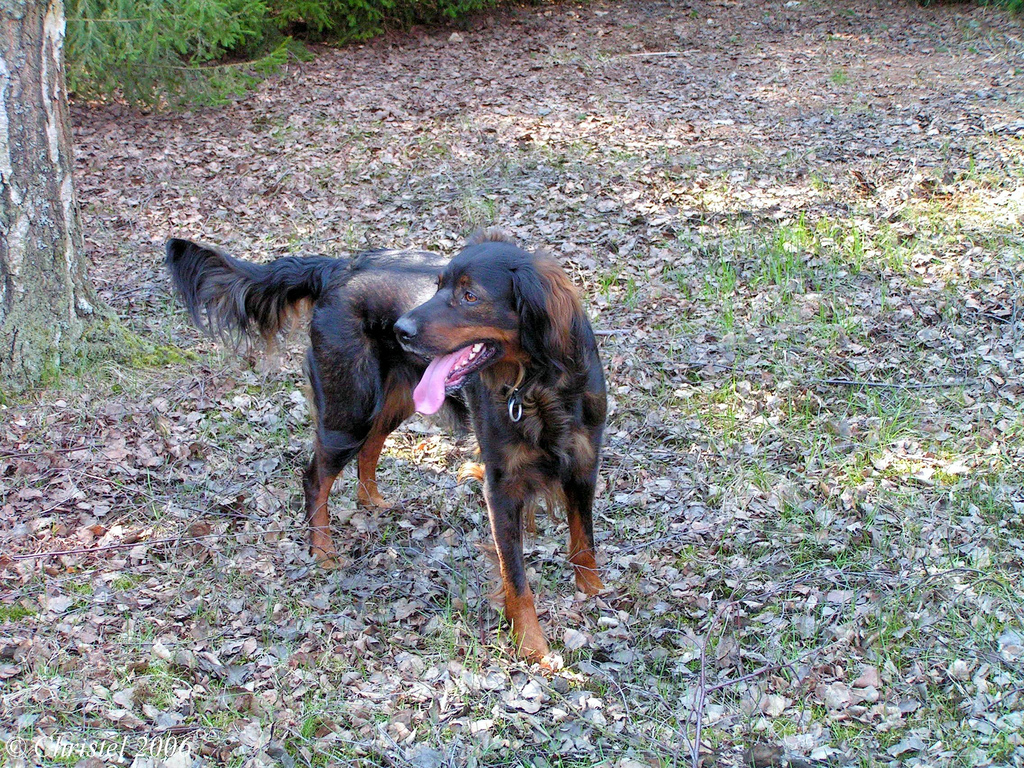
Is the Gordon Setter Right For You?
They do best in the company of human beings that are as active as they are. These dogs are completely devoted to their families. When brought up around children, Gordon Setters will do their best to protect these youngsters from coming to harm. These dogs are likely to leave the presence of a child that annoys them rather than display behaviors that may frighten kids such as growling or snapping, which makes them a good breed for families with young children.
Due to their high need for outdoor time, Gordon Setters aren’t very well suited to apartment life. They can adapt to city environments but may require a yard with a fenced in area for them to play in. These dogs should also be kept on leash when in town. These intelligent dogs can be stubborn and will not always follow orders blindly. They greatly benefit from having at least some obedience training.
In 5 Words
- Alert
- Fearless
- Loyal
- Confident
- Eager
Characteristics
Learn About the Gordon Setter
Description
General Description
These sturdy dogs are among the heaviest setter breeds. They were created for stamina and strength rather than speed, a fact which is reflected in their appearance. Members of this breed should look as if they are capable of spending whole days working out in the fields. Gordon Setters have square bodies. They move with a fluid gait and their tails held up like a flag. These dogs have a very thick, shiny coat with longer feathering on their tails, legs, and undersides. According to the American Kennel Club breed standards, these dogs should have a “bearing [that] is intelligent, noble, and dignified.”
Size
Males of this breed stand approximately 24 to 27 inches (61 to 69 centimeters) high. Female Gordon Setters measure between 23 and 26 inches (58 and 66 centimeters) tall. On average, males weigh between 55 and 80 pounds (25 and 36 kilograms) and females weigh between 45 and 70 pounds (20 and 32 kilograms).
Coat
Gordon Setters have lush coats that are either somewhat wavy or are perfectly straight. Curly coats are not permitted. Although members of this breed were originally known as black and tans, they come in other colors including black, red, liver, and white. These dogs typically have a black coat with colored markings on their paws, legs, throat, muzzles, and other locations on their bodies. White markings are also allowed on the chest area. A recessive red gene is present in this breed and may show up occasionally, even when adults of standard hues are bred together. Dogs that are mostly tan, buff, or red cannot be shown.
Short History of the Gordon Setter
The Gordon Setter is a breed that is native to Scotland where it was created in the early 1600s. These dogs descended from earlier spaniel varieties. Gordon Setters have an excellent sense of smell and were initially used as bird dogs. They would point at then retrieve fallen prey for the hunters they were accompanying. These dogs were popularized some two hundred years after they emerged as a breed by Duke Alexander IV of Gordon. Despite their excellent stamina, these dogs were not particularly fast or flashy and this contributed to their eventual decline in use. Once field trials became prevalent, the popularity of Gordon Setters began to wane. Members of this breed were nonetheless used in helping create the Irish Setter. These dogs eventually made their way over to the United States around the mid-1800s as a pair named Rachael and Rake. In 1892, the Gordon Setter breed was recognized by the American Kennel Club as a member of the sporting group.
Temperament
These lively dogs were bred for field work and are quite energetic as a result. They do best in the company of human beings that are as active as they are. These dogs are completely devoted to their families. When brought up around children, Gordon Setters will do their best to protect these youngsters from coming to harm. These dogs are likely to leave the presence of a child that annoys them rather than display behaviors that may frighten kids such as growling or snapping, which makes them a good breed for families with young children. Although they appear to have a serious disposition, these dogs are actually quite playful. Puppies in particular are incredibly rambunctious. These intelligent dogs can be stubborn and will not follow orders blindly. Gordon Setters are wary of strangers but are nonetheless quite well-mannered around unfamiliar persons. Yet they may become aggressive if unfamiliar dogs encroach on their territory.
Caring for Your Gordon Setter
General Health
These dogs are born in litters of 7 pups and live 11 years on average. Serious health concerns for this breed include hip dysplasia and gastric torsion. Progressive retinal atrophy is particularly problematic as Gordon Setters may carry a recessive gene that makes them prone to this condition. Other problems such as hypothyroidism, elbow dysplasia, cerebellar abiotrophy, and ear infections have also been known to occur in members of this breed. Regular hip, thyroid, elbow, and eye exams are recommended so that owners can spot problems before they arise.
Care
Daily
Gordon Setters need a great deal of exercise on a daily basis.
Weekly
Brushing and combing these dogs’ coats two or three times a week helps keep their coats from becoming matted or tangled. In order to prevent bad breath and reduce the potential for illness, it is a good idea to clean a dog’s teeth a few times per week. As the breed is prone to ear infection, the aforementioned appendages should be cleaned regularly as well as checked every week for any signs of infection.
Monthly
Flea, heartworm, and tick prevention medication is usually administered on a monthly basis in order to obtain the best results.
Grooming & Bathing
Gordon Setters should be bathed once every two weeks. The hair on the feet and their toenails should also be trimmed regularly.
Exercise & Training
Due to their high need for outdoor time, Gordon Setters aren’t very well suited to apartment life. They can adapt to city environments but may require a yard with a fenced in area for them to play in. These dogs should also be kept on leash when in town. These intelligent dogs can be stubborn and will not always follow orders blindly. They greatly benefit from having at least some obedience training. However, these dogs are also known for their eagerness to please their owners and their good memories. No retraining is necessary at the start of a new hunting season because these dogs will recall everything they already learned. Gordon Setters have a strong sense of smell and are excellent retrievers. They also like having a task to perform so they still make wonderful hunting dogs. Early socialization is recommended to keep these dogs from becoming overly fearful of strange people and animals.

